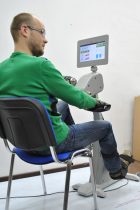Exercise is important for patients suffering from paralysis. “Patients suffering from paralysis, such as stroke victims, lose muscle mass quickly if they remain immobile,” says Rovshan Makhmudov, a physician and managing director of Orthorent, a Russian producer of rehabilitation equipment based in Moscow. “That impedes their recovery and often leads to complications. Exercise is good medicine!”
Exercise machines like those made by his company can help. With the “Moto” model, patients practice moving their arms and legs at three levels, with the electric motor moving the limbs either entirely on its own or in support of the patient’s own movements. In the latter case, the motor exerts an adjustable resistance against which patients act to develop their strength.
VarioDrive motor protects against muscle spasms
An important requirement was for the motor to work with the control system to reliably detect muscle spasms in the patient. In such cases, the motor has to stop the movement immediately to prevent injuries from occurring. “The Variodrive Compact from ebm-papst was a safe solution here since the control inputs for the motor electronics can be used to slow down or stop the motor or to change its direction of rotation,” says Makhmudov.
Another important criterion was the noise level. When several patients are using a rehab facility, high noise levels there mean stress for them. “Some of them already suffer from nervous conditions,” notes Makhmudov. “Quiet operation is an important and often underestimated factor in successful rehab.”
Frequency, not voltage
While developing the Moto, Orthorent made use of technical advice from ebm-papst in Russia. “First and foremost, we’re doctors and not engineers. So we were glad to have ebm-papst as a project partner. All we had to do was name our requirements and we got what we needed right away.”
An important requirement was for the motor to be powerful yet light and compact as well.
Rovshan Makhmudov, Orthorent
For example, the Moto’s electronics design called for a motor with a set value requirement based on frequency instead of voltage, as is usually the case. The technicians at the ebm-papst production site in St. Georgen made the necessary adjustments, simply assembling the circuit boards for the motor electronics accordingly before sending the shipment to Russia. The shape of the output shaft was also an issue. Normally it has the shape of the letter “D” to keep it from twisting. However, the gears for the toothed belt that Orthorent wanted to use didn’t fit here. So the engineers changed the shape of the shaft while also suggesting another way to keep it from twisting.
The network doctor
Makhmudov says, “One of our main requirements was for the motor to be powerful yet light and compact as well, because our machines get transported a lot.” Especially since the Russian ministry of health launched the world’s first program for remote home rehab in 2015. Russia is a huge country, so it’s often a long way to the nearest rehab practice. For many patients, being able to rent a machine and use it at home is important.
The Moto has an Internet connection so that such patients can still get medical supervision in spite of the distance. Using detailed exercise protocols, doctors can follow a patient’s progress from their desks. They can even adjust the machine’s settings for the patient during an exercise session. The motor also plays an important role here, according to Makhmudov. “Many of our competitors’ products still work with mechanical resistance. That makes them more difficult for immobile patients to operate, and there’s no way to adjust their resistance parameters via the Internet,” he says.



Leave a comment